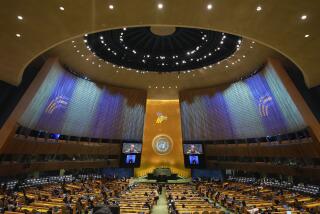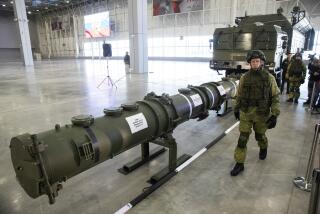Will Summit Free Leaders to Pursue the ‘Grand Compromise’?
- Share via
At their upcoming summit, President Reagan and Soviet leader Mikhail S. Gorbachev will sign a treaty removing from Europe nuclear missiles with ranges from 300 to 3,500 miles.
They have come to this so-called intermediate-range nuclear force, or INF, agreement not so much because they consider it important as because they find it convenient. Each sees it as a step to a broader arms control accord. The debate that will follow its signing, therefore, may emphasize not the merits of this treaty but the terms of the next one.
The two leaders decided that after two previous meetings consisting entirely of talk, this one required a treaty to serve as its centerpiece. Of all the potential treaties between the United States and the Soviet Union, the one on INF proved easiest to conclude.
Both Reagan and Gorbachev hope that it will lead to a least one more summit meeting and one more nuclear arms control agreement before the President leaves office. But there are at least two possible successor treaties, and both are controversial. The controversies that they provoke may dominate the debate about INF.
The next agreement that both would prefer is what has come to be called the “grand compromise.” It would dramatically reduce offensive strategic nuclear armaments on both sides. These are the weapons of intercontinental range that are carried by land-based and submarine-launched missiles and on bomber aircraft. Strategic weapons were the subjects of the two SALT treaties--the first one signed in 1972, the second in 1979 and obeyed but never formally ratified by the United States.
The two governments have worked out a rough agreement on substantial reductions of strategic armaments on both sides. Important differences remain, but a final treaty could probably be concluded with a few months of hard bargaining. The Soviet side has insisted, however, that such a treaty be accompanied by limits on defenses against missile attack. They want the United States to agree to extend the 1972 treaty prohibiting such defenses for at least 10 years.
They also want assurances that the American interpretation of that treaty is the same as theirs. Their aim is to prevent Reagan’s Strategic Defense Initiative from becoming a full-fledged system of space-based defenses.
The President would like to achieve the proposed reductions in strategic forces, thereby crowning his presidency with the most sweeping arms control agreement in history. So far, however, he has refused to accept the restraints on defensive programs that Gorbachev is demanding. It was over this issue that their Reykjavik summit broke down.
There are deep divisions within the foreign policy community, Congress and the Administration itself over the question of whether to limit defenses in order to achieve reductions in offense. Both sides regard the grand compromise as, for better or worse, more important than INF, and the debate about it is likely to go into high gear as soon as that treaty is signed.
An offense-for-defense trade, however, is not necessarily the next item on the agenda of arms control.
There is growing support, both in the United States and Europe, on the part of both those who favor and those who oppose the grand compromise, for concentrating instead on negotiating reductions in the non-nuclear weapons and troops--the “conventional” forces”--stationed in Europe.
The Warsaw Pact armies are widely regarded in the West as stronger than those of the North Atlantic alliance. The West must therefore count on its nuclear weapons to redress the imbalance and prevent war.
Under the terms of the INF treaty, NATO will still have a formidable array of nuclear weapons available for European defense. Nonetheless, many believe that the treaty will confer greater importance on conventional weapons and therefore make it imperative to the non-nuclear imbalance.
This will not be easy to do. Negotiations on this issue have dragged on for 15 years. Western governments have contended that because the Soviet Union enjoys an advantage, the Warsaw Pact nations must make deeper reductions in its forces than NATO.
This is a position to which the Soviet Union has not been entirely sympathetic. Nor is it clear that the Western allies can agree among themselves on just what the conventional balance in Europe ought to be. Successful negotiations with the Soviet Union will require, first, successful negotiations within NATO, which will not be easy to achieve.
The INF treaty is likely to open the door to the debates on whether the West should concentrate next on reductions in strategic nuclear weapons or nonnuclear forces and what the outcome of either set of negotiations ought to be. The treaty may thus be notable not for what it accomplishes but for the hopes and fears it provokes about what comes next.
More to Read
Sign up for Essential California
The most important California stories and recommendations in your inbox every morning.
You may occasionally receive promotional content from the Los Angeles Times.










